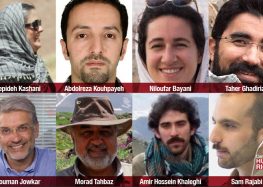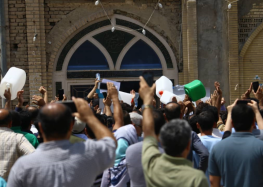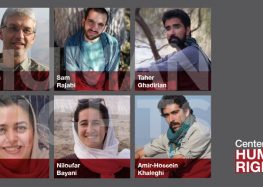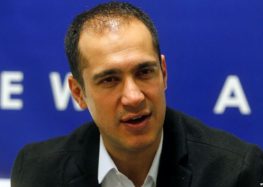Lawyer Who Took on Ahmadinejad Says Iranians Should Sue Government for Pollution Crisis
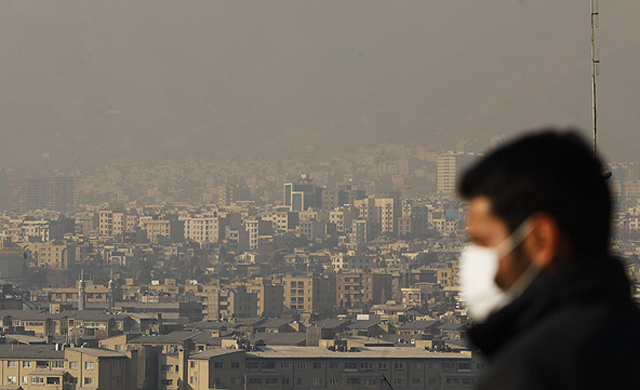
Iranians have a constitutional right to take their government to court and seek damages for worsening environmental pollution, attorney Mostafa Tork Hamadani told the International Campaign for Human Rights in Iran.
Hamadani previously made headlines suing the Ahmadinejad government (2005-2013) for allegedly distributing sub-standard gasoline that contained dangerous particles.
Now he is arguing that Iran’s Constitution makes the state responsible for protecting the environment and therefore liable for deaths caused by pollution.
In an interview with the Campaign, Hamadani referred to Article 50 of the Constitution, which states: “The preservation of the environment, in which the present as well as the future generations have a right to flourishing social existence, is regarded as a public duty in the Islamic Republic. Economic and other activities that inevitably involve pollution of the environment or cause irreparable damage to it are therefore forbidden.”
Hamadani also noted that Article 688 of Iran’s Islamic Criminal Code requires the Health Ministry, Environmental Protection Organization and the National Veterinary Organization to take action against environmental polluters.
“Accordingly, people can also go to court and seek damages for any harm, especially to their health, as a result of pollution,” he said.
Every hour two people—or more than 17,000 a year—die in Tehran from air pollution poisoning, Deputy Health Minister Ali Akbar Sayyari said during Friday prayers in Tehran on April 25, 2014, as reported by the Jame-e-Jam news website.
Transportation official Mehdi Ghat’ee told the Iranian Student News Agency (ISNA) on November 18, 2013 that air pollution kills 45,000 people every year in Iran.
The increasing number of deaths due to air poisoning led Mohammad Nazemi Ardakani, the head of the National Organization for Civil Registration, to announce an apparent correlation between the rise in air pollution and increasing deaths—especially in larger cities—in March 2014.
Dire Situation
For years Tehran has been ranked among the world’s most polluted capitals, but the life-threatening problem extends well beyond the city’s 8 million inhabitants.
Speaking on Clean Air Day, Masoumeh Ebtekar, head of the Environmental Protection Organization, said poor air quality was affecting nearly 35 million Iranians, well over a third of the country’s population.
“If we don’t find a solution to this problem, we are going to have multiple, serious health issues,” she said on March 25, 2014.
In southwest Iran, polluted dust frequently blowing in from neighboring Iraq has been blamed for severe breathing problems, especially in Khuzestan Province.
Despite numerous protests, people have been told to tolerate the situation because, according to Ebtekar, little can be done to counter the dust storms due to the “insecurity in Iraq.”
Mohammad Esmail Akbari, head of Iran’s Cancer Research Center, said 15 years of research by the World Health Organization has shown air pollution to be a major factor in causing cancer.
The main air polluters in Iran—power plants and automobiles that burn sub-standard fuels—contribute to lung-related ailments, including cancer, and thus constitute one of the major causes of death among Iranians, added Akbari on January 5, 2015, according to Shahrvand newspaper.
The government drafted a five-year plan in 2000 to combat pollution by producing cleaner fuel-burning cars, decommissioning old cars, requiring regular smog tests and expanding public transportation, particularly rail networks.
But Iranians have yet to see substantive results.
“The plan was ready for implementation, but unfortunately it underwent some changes in the following years,” said Ebtekar, according to the Iranian Students Correspondence Association (ISCA), on January 4, 2016.
In fact, the only sign of official action on Iran’s pollution problems has come in the form of regular smog warnings sending students home early from school and asking people to stay home.
“Whenever there’s a dust storm or pollution covers the capital, we hear talk about mobilizing various government agencies to combat this crisis,” wrote Mohammad Salari, chairman of the Tehran City Council’s Urban Development Committee, in an op-ed published on December 25, 2013 in the Mag Iran newspaper.
“They insist that they can solve the problem overnight, but unfortunately they forget that these hurried decisions are making the problem worse,” he wrote.
“We have had plans to reduce air pollution but nothing significant has been done,” said Mohammad Haghani, deputy chairman of the Tehran City Council’s Health and Environment Committee.
“The reason is that this problem cannot be solved with legislation alone,” said Haghani, in a speech to Parliament on October 22, 2013, according to the Iranian Labor News Agency (ILNA).
“We must take effective steps to prevent polluting vehicles and motorcycles from being on the roads,” he added.
“Catalytic converters should be replaced. Heavy vehicles should be regularly checked for pollution levels and old buses and minibuses should be equipped with smog filters,” he said. “These are some of the issues we can deal with.”
The Tehran City Council has meanwhile been accused of exacerbating the pollution problem by cutting down trees and reducing the city’s green areas.
Haghani told the Iran-Emrooz newspaper, in an interview published on March 17, 2016 that 12,000 trees were cut down to build an extension for Imam Ali Highway in Tehran’s Lavizan district and many more trees were removed in Chitgar Park for road construction.
“The municipality has received some complaints about these developments, and once in a while we hear a lot of noise about it, but these protests never have enough force to stop such things from happening,” he said.
Haghani previously told the Khabar Online news site, on December 17, 2015, that “in the past 10-15 years, four to five thousand hectares of urban orchards had been destroyed” due to the lack of proper city planning and greedy land speculation.
In March 1989, there were 14,167 hectares of urban orchards in Tehran. But 20 years later that number had dropped to less than 10,000 hectares, said Haghani on December 17, 2015.



